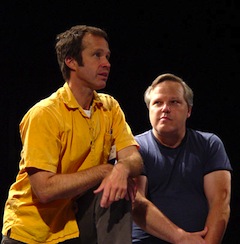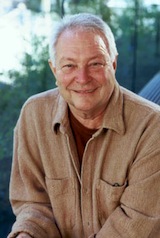Top News #1: S.F. Opera Upholds 88-Year-Old Tradition
Ask David Gockley the story about the next season and the San Francisco Opera general director says it's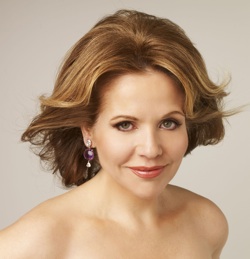 that "there is a season at all."
that "there is a season at all." Under continuing pressure from the recession, whose impact is not expected to ease until two years after the economy's recovery, Gockley is putting up a big fight to uphold San Francisco Opera's tradition of varied repertory, new works, and world-renowned singers.
"Despite these continuing hard financial times," Gockley says, "seven of our nine productions for the 89th season will be new to the War Memorial Opera House stage." (Having completed the difficult preparation of many months, Gockley is off to Houston for the birth of his first grandchild.)
The 2011-2012 season offers the world premiere of Heart of a Soldier, by Christopher Theofanidis and Donna Di Novelli (with Thomas Hampson and Merola-Adler alumna Melody Moore); company premieres of Donizetti's Lucrezia Borgia (Renée Fleming and Francesco Meli), Handel's Xerxes (Susan Graham and David Daniels), and John Adams' Nixon in China (Brian Mulligan), which had its world premiere in 1987 at the Houston Grand Opera when Gockley was heading that company.
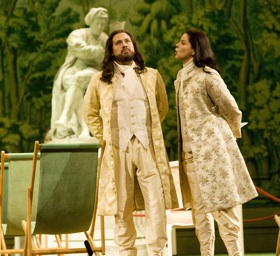
Productions new to San Francisco are Mozart's The Magic Flute, designed by Jun Kaneko; Mozart's Don Giovanni (Lucas Meachem and Ellie Dehn), by director Gabriele Lavia and designer Alessandro Camera; and the Teatro alla Scala coproduction of Verdi's Attila, with Ferruccio Furlanetto in the title role.
There will be cash-cow revivals of David Hockney's production of Puccini's Turandot (Iréne Theorin) and Jean-Pierre Ponnelle's production of Bizet's Carmen (Kate Aldrich, Italian-Brazilian tenor Thiago Arancam, and Polish-Brazilian baritone Paulo Szot).
Special events include a long-awaited tribute concert celebrating Frederica von Stade at Herbst Theatre, on Dec. 3, together with San Francisco Performances, Cal Performances, Philharmonia Baroque Orchestra, and the San Francisco Conservatory of Music.
The Opera Orchestra, led by Music Director Nicola Luisotti, will give concerts in UC Berkeley's Zellerbach Hall, on Oct. 28, 2011 and June 3, 2012.

Luisotti will conduct four productions (Don Giovanni, Carmen, Attila, and Turandot shared with Giuseppe Finzi), Patrick Summers two (Soldier, Xerxes), with company debuts by three youngish conductors: Italian Riccardo Frizza, 39 (Borgia), Holland's Lawrence Renes, 40 (Nixon), and Scotland's, Rory Macdonald, 39 (Flute).
On a projected $70 million budget, the company is offering 52 performances in the fall, and 22 in the summer, which means the challenge of selling approximately 240,000 tickets in the 3,146-seat Opera House.
Even if there is only standing room left for every performance — an impossible expectation — the estimated ticket revenue would still not cover half of the operating budget. To continue finding donations in bad or just uncertain economic times is the biggest challenge for the Opera, which maintains high standards producing the most expensive all art genres.
Season subscriptions run from $160 to $2,882 for the full season, available now. Single tickets, available beginning July, cost $21 to $330. Season subscriptions represent up to 30 percent saving over single tickets, additional donations suggested. The traditional $10 standing-room price in the Opera House will continue to be maintained.
The Sept. 25 Webcor Builders Presents Opera at the Ballpark simulcast of Turandot at AT&T Park is free and open to the public, but advance online registration is recommended.
Top News #2: Defying Recession: Wilsey Center for Opera
 Saving cultural institutions in the days of the Supercommittee failure and continuing recession is hard enough. To build and expand are rarer than hens’ teeth.
Saving cultural institutions in the days of the Supercommittee failure and continuing recession is hard enough. To build and expand are rarer than hens’ teeth. To follow up on the Nov. 8 report here about the reconstruction of the San Francisco War Memorial Building and the future of the vital venue of Herbst Theatre, we turned to David Gockley.
Gockley has urged an addition to the War Memorial ever since he became general manager of the San Francisco Opera six years ago. He had wanted what he calls “a patch,” similar to the Franklin Street annex to the Opera House that was added during the Adler years.

The reason for his mission: the great cost and logistical nightmare of scene and costume shops, rehearsal facilities, office space scattered around town — rent, utilities, transportation, communications costing about $1.5 million a year. The problem with the proposed annex: an estimated cost of approximately $60 million dollars.
That was not to be, but a pretty good substitute came about when Gockley received a phone call from Elizabeth Murray, managing director of the city’s War Memorial and Performing Arts Center, planning for the 2013–2015 seismic retrofit. Gockley recalls:
She asked if we would be interested in the fourth floor of the reconstructed War Memorial, former home of the S.F. Museum of Modern Art. Here was another opportunity on the table, and at an estimated $20 million total cost, it was clear that there we could accommodate everything but the scene shop, which we are phasing out anyway.(Storage is being handled at a Pier 96 site rented from the Port Commission, where 280 containers are used for scenery.)
To raise funds, Gockley started a naming-gift campaign, honoring donors by naming various locations on the fourth floor after them. First up: Fine Arts Museums of San Francisco president and major philanthropist Dede Wilsey, with a $5 million gift. The entire facility will be called the Wilsey Center for Opera.
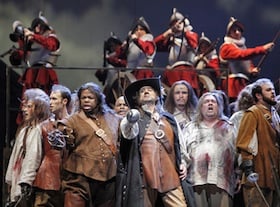
The Center will provide substantial office space for the company (allowing transfer from the current Ivy Street location), as well as costume storage, plus two multipurpose rooms for orchestra and staging rehearsals, board meetings, and social events. The larger room (not yet named) will be a 300-seat performance venue, complete with dressing area and green room; the same space, using risers, will serve for chorus rehearsals.
Architect for the Wilsey Center will be the San Francisco firm of Mark Cavagnero Associates, recently responsible for major reconstruction projects of the Oakland Museum of California and ODC Dance, among many others, and currently working on the coming SFJAZZ building in the Civic Center. No acoustician has been selected yet.
Wilsey Center should be a reality by 2015, a year before Gockley’s recently extended contract is up. As of now, Gockley, 68, says retirement will follow.
Speaking of the future, while awaiting season announcements, Gockley would only give a (heartening) “yes” to the question if there will be works by Berlioz and Janáček among them. When it comes to the long-anticipated Les Troyens, he said that if and when it arrives here, it will not be the Richard Jones production from the English National Opera, originally planned by Gockley’s predecessor to be a San Francisco coproduction.
Another coproduction, of Wagner’s The Flying Dutchman, with Liège’s L’Opéra Royal de Wallonie, is still not announced here officially, but Gockley was willing to talk about it.
When he asked Petrika Ionesco if he would be interested heading a production here, the man responsible for San Francisco/Théâtre du Châtelet Cyrano de Bergerac last year told Gockley that he is already working on a production in Liège. The logical next step was to create a partnership with the Belgian company, where Dutchman is opening this week.
Top News #3: Forging the Ring and Opera's Future
There is good news about San Francisco Opera's upcoming summer season of three Ring cycles. SFO General Director David Gockley told a meeting of contributors last week that all but $500,000 of the $24 million special budget has been raised already, and 84 percent of the tickets are sold.
Otherwise, SFO’s finances in the world of a continued recession continue to present a great challenge. Fiscal 2010 had a deficit of $1.5 million on the annual operating budget of $65.2 million, and the future requires the company to do more with less, while getting rid of the deficit.
Included in those figures is approximately $10 million borrowed from the company endowment for running costs, which must be repaid within a limited period. Sale of property on Indiana Street within five years may be the solution.
While Gockley's long campaign for use of an annex to be built at the neighboring War Memorial Veterans Building is unsuccessful, there is a next-best-thing scenario with the offer of the use of the fourth floor and basement after the building undergoes seismic retrofit and reconstruction in 2013.
Additionally, SFO is expecting to have the use of Herbst Theatre, which will be expanded and modernized — meaning it is to have a real stage and backstage facilities.
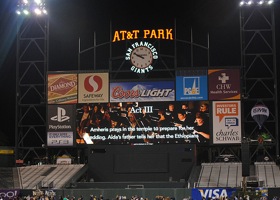
Top priorities for Gockley and the administration is to expand the contributor base — currently half of all donations come from 15 families — and deal with upcoming labor negotiations taking place before contracts expire on July 31. (Incidentally, San Francisco Symphony's labor contracts expire November 2012, soon after the beginning of the 101st season.)
Gockley stressed the importance of increasing membership of the pivotal Bel Canto Society from the current 300 to 1,000 members by 2016.
Look for several stagione productions in the near future, such as a dozen performances of a popular opera with star power, say Tosca, with Angela Gheorghiu and Patricia Racette.
The next Opera in the Ballpark performance — of Turandot on Sept. 25 — will be a matinee, rather than in the evening, because of... Cal football! Apparently, the team's switch to AT&T Park will force the change. Will the HD telecast be visible in daylight? Gockley said that, since previous shows used only one-third the available power on the big screen, that should not be a problem.
Top News #4: Music of the Subcontinent
 The Asian Art Museum’s new exhibit, Maharaja: the Splendor of India’s Royal Courts, is a fine focal point for the music of India, Pakistan, and Bangladesh in the Bay Area — an important subject not coming up all that often in a local context.
The Asian Art Museum’s new exhibit, Maharaja: the Splendor of India’s Royal Courts, is a fine focal point for the music of India, Pakistan, and Bangladesh in the Bay Area — an important subject not coming up all that often in a local context.
To make up for that, here’s a triptych: a personal — and admittedly quirky — report about the best of Bollywood film scores, a look at our vital cultural connections, and a list of some exhibit-related events.
With ‘Khwaja Mere Khawaja,’ Against the World
Suggest starting with the video, even before reading about it. Then check out “Azeem-O-Shaan-Shahenshah,” with India’s finest Wagner tubas. The deeply Moslem background? If you have no problem with Bach grounded in Christianity, the presence of Mecca against this music should be just fine.
The business about this popular (but not pop) music came up last week, though it’s been an interest of mine for years. After a couple of surprising exchanges at last week’s opening of Maharaja about a snippet from the Bollywood film Jodhaa Akbar shown in the exhibit, I conducted a scientific survey.
It consisted of asking Qamar Adamjee, the local curator, V&A curator Anna Jackson (whose charming title is “Keeper, Asian Department”), an attending Indian Princess (royalty in a republic?), and such, with the following result: Jodhaa Akbar is much disliked on the subcontinent, especially by those (such as the ones mentioned here) who haven’t seen it.

Well, I have, and I can say with certainty that it’s a pretty good Bollywood flick. The problem may be with feelings about the protagonist, Jalal ud-Din Muhammad Akbar, the third Mughal Emperor, and apparently a great ruler who wasn’t considered as such by some of the inevitably oppressed, and their descendants.
The reason Jodhaa Akbar sticks in my mind (unlike dozens of others Bollywoodians) is “Khwaja Mere Khawaja,” a hypnotic and ecstatic Sufi song by — surprise! — A.R. Rahman, India’s answer to Andrew Lloyd Webber in commercial success, though of more substance and variety.
Sufi and qawwali are birds of a feather, and “Khwaja Mere Khawaja” is a mild-mannered introduction to my favorite Nusrat Fateh Ali Khan, and the whole ecstatic qawwali literature.
Maharajas and the Bay Area
When the Beatles’ George Harrison embraced Indian culture and Hinduism in the mid-1960s, he and Ravi Shankar became, well, instrumental in expanding Western awareness of Indian classical music and spirituality.
Harrison followed the 1971 Concert for Bangladesh with a world tour. A milestone in that campaign was a legendary concert in Marin’s Ali Akbar College of Music, the school founded and headed by Ali Akbar Khan, known by the honorific Khansahib.
The great sarod virtuoso, who died two years ago, at age 87, bridged the American present with the past age of the Indian maharajas. He and his revered father, Allauddin Khan, had been at the center of Hindustani classical music for over a century, and both served in princely courts of maharajas.
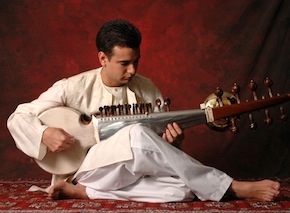
For half a century, Khansahib’s concerts around the Bay, his hundreds of students, and the ongoing school in Marin — led by his sons — have been a prime example of the presence of Indian culture in the city now hosting the Maharaja exhibit.
A new film biography of Khansahib, narrated by his son, Alam, is being shown at the ninth annual San Francisco International South Asian Film Festival, “3rd I,” taking place Nov. 9–13. Play Like a Lion, which premiered a couple of weeks ago at the Mill Valley Film Festival, is screening in the Roxie at 4:30 p.m., Nov. 13.
California has more than 4 million residents of Asian descent, including some 300,000 of Indian subcontinental heritage — present-day India, Pakistan, and Bangladesh. Their influence has permeated every aspect of society, from music to food, from yoga and meditation classes to technology.
Offspring of this ancient civilization have been in the vanguard of the 20th-century miracle of Silicon Valley. Vinod Khosla is cofounder of Sun Microsystems and investor in dozens of startups; Gururaj Deshpande launched Sycamore Networks; Suhas Patil started Cirrus Logic; Prabhu Goel founded Gateway Design; Kanwal Rekhi started and ran Excelan until it merged with Novell — only a smattering of the thousands of entrepreneurs, investors, engineers, and customer support workers from the subcontinent in and around the Valley.
A recent study found that immigrants account for one-third of the scientific and engineering workforce in Silicon Valley, while Indian and Chinese chief executives are running one-fourth of the high-technology firms in the region.
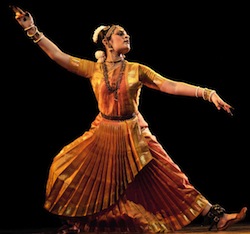
According to Fortune magazine, “Bay Area Indian immigrants represent America’s most successful immigrant group. Collectively, they’ve created companies that account for $235 billion of market value.”
Partially as a result of this influx, Indo-Pakistani restaurants in the San Francisco–San Jose corridor now number in the hundreds. From simple curry diners to vegetarian places in strip malls to specialty houses such as Dosa, and the prize-winning restaurants Asoka, Mehfil, Indian Oven, and Gaylord, choices are mouthwatering and many.
The region is also home to dozens of Indian cultural organizations, serving Bengali, Goan, Gujarati, Sindhi, Tamil, Punjabi, and other communities.
Besides the world-renowned Ali Akbar College of Music, the Chitresh Das and Abhinaya dance companies, as well as Bal Bharati, Chhandam, Kalanjali, Prabhath Academy, and other schools, all operate here successfully.
Events
A few programs and events from the vast store of entertainment around the Maharaja exhibit, in the Asian Art Museum:
India Comes Alive with Music, Dance, and Art
Art and dance teachers from the Indian Community Center in Milpitas introduce India’s cultural festivals, dance traditions, and traditional art activities. [Nov. 18–20; Dec. 16–18; Feb. 17–19; March 16–18/noon to 4 p.m./free with museum admission]
Family Fun Activity: Dance!
Hip-hop, funk, and reggae songs are the soundtracks for contemporary forms of Bhangra dance. In this workshop for tweens, learn to dance Bhangra like a Bollywood star. [Dec. 29/1–¬3 p.m./members free, nonmembers $2 per person/suggested for children 10–13]
South Indian Music and Dance
Carnatic violinist A. Kanyakumari performs with percussionist Pathri Satish Kumar and violinist Nishant Chandran, and featuring bharatanatyam dancer Pallavi Sriram. Copresented with Pallavita. [Nov. 6/11 a.m. and 2 p.m./a Target First Free Sunday Program]
South Indian (Carnatic) Music
The Sri Lalitha Gana Vidyalaya School youth musicians present two concerts of Carnatic music. Sing along with the students at the morning performance. [Dec. 3/11 a.m. and 2 p.m./a Target First Free Sunday Program]
North Indian Dance The Chitresh Das Dance Company performs Kathak dance. Instruction and participation for children ages 3–5 at the morning performance. [March 4/11 a.m. and 2 p.m./a Target First Free Sunday Program]
Indian Sitar Maestro Ashwin Batish and Family
A demonstration of Indian sitar (plucked stringed instrument) and tabla (drum) music, with repertoire ranging from classical to fusion. [March 23–25/noon–4 p.m./free with museum admission]
South Indian Dance (Bharatanatyam)
The famed Abhinaya Dance Company performs Bharatanatyam dance. The morning performance includes instruction and participation for children ages 3–5. [April 1/11 a.m. and 2 p.m./a Target First Free Sunday Program]
Screenings
- Films for Kids, Dec. 11: “Chandani: Daughter of the Elephant Whisperer,” 2010 (11:30 a.m.); “Like Stars on Earth,” 2007 (2:30 p.m.)
- Films for Lovers, Jan. 8: “Umraojan,” 1982 (11:30 am); “The Greatest of the Mughals,” 1960 (2:30 p.m.)
Top News #5: Operas for Our Time: A for Effort
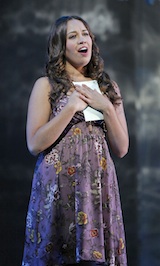 However ambiguous you may feel about the mix of history, hype, (literal) flag-waving, a huge production effort (including a dozen Merola/Adler veterans, from Thomas Hampson to Patrick Summers to such young talent as Nadine Sierra), and the possible elevation of Chris Theofanidis into a top rank of American composers, San Francisco Opera’s general director, David Gockley, deserves credit for producing Heart of a Soldier, and for what it represents.
However ambiguous you may feel about the mix of history, hype, (literal) flag-waving, a huge production effort (including a dozen Merola/Adler veterans, from Thomas Hampson to Patrick Summers to such young talent as Nadine Sierra), and the possible elevation of Chris Theofanidis into a top rank of American composers, San Francisco Opera’s general director, David Gockley, deserves credit for producing Heart of a Soldier, and for what it represents. When Heart premiered in the War Memorial Opera House Saturday night, responses ranged widely, from the evenhanded to the damning, to Jeff Dunn’s thorough one in SFCV.
Yet an important aspect of the premiere has not been emphasized: It is part of Gockley’s ongoing effort to keep opera alive through relevant content, rather than with cheap shock “values” of Eurotrash.
For at least two decades, in Houston and San Francisco, Gockley has marshaled money (during the Enron meltdown there, the Great Recession here), talent, and audiences to present operas with contemporary themes.
Among them: John Adams’ Nixon in China (1972), Carlisle Floyd’s Willie Stark (1981), Michael Daughterty’s Jackie O (1997), Jake Heggie’s The End of the Affair (2004), Stewart Wallace’s Harvey Milk (1995) and The Bonesetter’s Daughter (2008), Philip Glass’ Appomattox (2007), and many more.
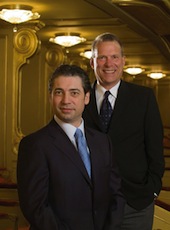
In the program notes for Heart of a Soldier, Gockley wrote about the difficult but essential connection between art and contemporary reality, emphasizing the purpose, not the problems:
On the heels of the [9/11] tragedy, the New York Philharmonic commissioned John Adams to compose On the Transmigration of Souls, a heartfelt and profound reaction to the events, at which point Adams said, ‘Music has the singular capacity to unlock people’’s imprisoned emotions, and bring us face to face with our raw uncensored, unattenuated feelings. That is why during times when we are grieving or seeking to get in touch with the core of our beings, we seek out those pieces that speak to us with that sense of gravitas and serenity.’Cataclysmic world events have inspired many great works of art. Shostakovich’’s Seventh Symphony was a response to the death and heroism of the people of Leningrad as they withstood the Nazi onslaught in World War II. Picasso’’s Guernica, Goya’’s The Disasters of War, Spielberg’’s film Schindler’s List, Fondakowski’’s play The People’’s Temple (about the Jonestown massacre), and Guterson’s book Snow Falling on Cedars (dealing with our government’s internment of Japanese Americans during World War II) are but a few examples of artists’ reactions to large-scale tragic events.
In expressing themselves in this heightened way, they not only speak for themselves, they speak for all of us, providing a communal catharsis. Even isolated tragedies inspire artistic expression, like the central movement of Christopher Rouse’s Flute Concerto, which was inspired by the abduction and murder of a two-year old English boy, ‘a small token of remembrance for an innocent life senselessly and cruelly snuffed out.’ ...
Will Heart of a Soldier be this successful? Who knows. The important thing is to get these pieces launched with fanfare and good attendance, and then they are on their own! For better or worse, my career as an opera producer has been punctuated with many of these launches. My work will be judged by the quality of the pieces I have midwifed, and in most cases I will be long gone before the juries render their ultimate verdicts.
Top News #6: Gertrude Stein, Alas?
While very much appreciating Gertrude Stein’s role in promoting modern art (“The Steins Collect: Matisse, Picasso, and the Parisian Avant-Garde” is terrific; closes on Sept. 6!), I am not a fan of her writing. That, of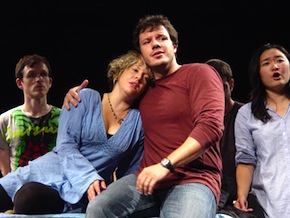 course, would be completely inconsequential, were it not for the approaching production of the Thomson/Stein Four Saints in Three Acts.
course, would be completely inconsequential, were it not for the approaching production of the Thomson/Stein Four Saints in Three Acts. The joint production — by Ensemble Parallèle, SF MoMA, and Yerba Buena Center for the Art — features some prominent artists. Nicole Paiement conducts, Brian Staufenbiel is stage director, and the cast includes Heidi Moss (Saint Teresa I), Kristen Choi (Saint Teresa II), Eugene Brancoveanu (Saint Ignatius), J. Raymond Meyers (Saint Stephen), Jonathan Smucker (Saint Chavez), Maya Kherani (Saint Settlement), Jason Detwiler (Saint Plan), Brooke Munoz (Saint Cecilia), Nicole Takesono (Saint Sarah), and others.
Are you counting Saints? Yes, more than four. That’s part of Stein’s jocosity. The three acts turn out to be two, sort of: “A Heavenly Act” prologue, with music by Luciano Chessa, and Thomson’s opera proper, in one act.

In a Fox-free effort to be fair and balanced about Ms. Stein, I turned to born-again Stein fanatic Mike Strickland, of the Civic Center blog, and a prominent supernumerary in the production. Here’s his position on the controversy (which is certain to exist beyond just the two of us):
Gertrude Stein, while making it a joke by proclaiming it so publicly and repeatedly, was a Serious Genius. She studied at Harvard as a young woman under William James, brother of Henry, and was probably James’ favorite philosophy/psychology student.What she was attempting in her writing was to convey extremely complex thought using the simplest of language. Sometimes it works, sometimes it doesn’t, but there’s nothing phony about it.
What’s most important about Four Saints in Three Acts is that it allowed Virgil Thomson to write vocal music that wasn’t dependent on narrative or emotional content and to simply play with the problem of how best to set English to music. Much of the score is successful simply as earworm music, and part of the reason for that is because the words and music do fit so well together.
Though the libretto doesn’t “mean” anything in a traditional narrative form, it has an inner meaning and an outer sound that is genuinely hypnotic and Thomson captures it. I didn’t use to think this way about the piece, based on a recording of the full opera on Nonesuch and the Mark Morris ballet version which both bored the hell out of me.
What’s changed is this: hearing the Thomson recording from the early 1960s recently for the first time with his all-black cast really swinging; reading Gertrude Stein for the last four months in her series of autobiographies; and hearing Ensemble Parallèle conductor Nicole Paiement creating wonders with the music during rehearsals.
Top News #7: Flicka Gala: So Much More Than Opera's First Lady
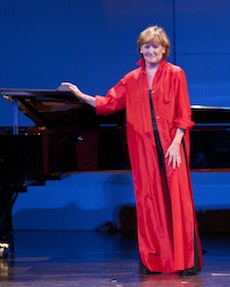 "Joyce DiDonato and Susan Graham are here courtesy of the Metropolitan Opera," Marilyn Horne told a full house in Herbst Theater Saturday. "Richard Stillwell is here courtesy of the Chicago Lyric. I am here courtesy of Sloan-Kettering and Johns Hopkins."
"Joyce DiDonato and Susan Graham are here courtesy of the Metropolitan Opera," Marilyn Horne told a full house in Herbst Theater Saturday. "Richard Stillwell is here courtesy of the Chicago Lyric. I am here courtesy of Sloan-Kettering and Johns Hopkins." Who but Horne can elicit howls of laughter with a reference to overcoming a particularly deadly kind of cancer?
Not Zheng Cao, who battled metastasized stage-four lung cancer and two dozen brain tumors, with Flicka at her side. Heroic (and triumphant) as that struggle was, tonight Zheng dissolved in tears singing "You'll Never Walk Alone." She and Flicka, Zheng said, sang that and much else "in hospital corridors and during biopsy."
But "Celebrating Frederica von Stade" was otherwise a lively, happy evening, reflecting the personality of the celebrant. Never assuming the mien of a Diva, this true star burst on the stage hilariously with a breathless "Non so piu cosa son." It was in the role of Cherubino that Flicka made her San Francisco debut in 1972.
And she and Horne made it sure realism, truth-telling, and humor permeated what could have turned into a formal and official occasion. "You are such a wonderful person," Horne gushed, "I don't think I ever knew you have an evil thought." With a raised eyebrow, Flicka responded: "That's because you weren't around during my divorce."
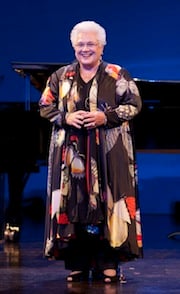
At 66, Flicka is as vibrant and fabulous as ever. She sang through the 2 1/2-hour event without a look at a score. And the voice is in good shape, somewhat diminished in power, but otherwise it's "all Flicka."
As Nancy Adler Montgomery, Sarah Billinghurst, Ruth Felt, David Gockley, and her fellow singers sang her praises as an artist and "the most giving person in the world," Flicka took it all in stride, returning the event again and again from a Grand Occasion to a concert.
There are few artists in the world who are called — globally and constantly — "beloved" the way Flicka is. But nowhere is that sentiment as sincere and intense as in and around San Francisco, her home, where she has not only participated in the work of so many musical organizations, but where she launched and supported so many careers, from that of Jake Heggie to thousands (yes) of children, mostly underprivileged.
At her initiative, the gala evening's proceeds are going to two of the institutions she has long supported: UC Berkeley's Young Musicians Program and the St. Martin de Porres Catholic School in Oakland.
Musical highlights of the evening included Flicka's understated performance of Mahler's "Liebst du um Schonheit," "Send In the Clowns" from A Little Night Music (sung in place of a scheduled duet with Thomas Allen, who couldn't make it, and sent a touching love letter instead, read by Gockley); an aria from L'Enfant et les Sortileges; a modified and updated "Let's Call the Whole Thing Off" with Samuel Ramey; and "The Years Roll By" with Kiri Te Kanawa.
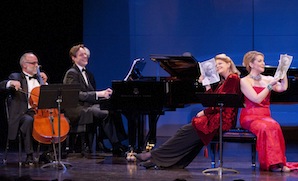
A moving "Sciogli, sciogli la lingue" duet from Il Ritorno d'Ulisse in Patria with Stillwell was a high point of the evening, along with DiDonato's "Hotel" by Poulenc. DiDonato also sang an aria from La Cenerentola, the opera in which she made her local breakthrough as a Merolina in Stern Grove.
Te Kanawa looked great and her speech was sincere and convincing, but the voice is threadbare, especially in a painful rendition of "Ach, ich fühl's" from The Magic Flute. However, it wasn't her fault alone that the Rosenkavalier Trio fell flat and disjointed. Te Kanawa's Marschallin, Graham's Octavian, and Susannah
r's Sophie simply didn't come together, probably due in part to lack of rehearsal.
There must have been very little preparation available for the rest of the evening, and yet besides those exceptions, it all went well, some thrillingly so.
Heggie and John Churchwell provided piano accompaniment, SFO musicians Kay Stern, Emil Miland, and Jose Gonzalez Granero participated.
My regret: Flicka's now-thwarted dream of departing the stage in the role of the Marschallin wasn't even ameliorated tonight by assigning her to the Trio. It would have gone better with her, without a doubt. Chances are it bothers me more than Flicka; she looked radiant joining for the final chorus, the wistful-and-accepting "Some Other Time," from On the Town.
"Just when the fun is starting,
Comes the time for parting,
But let's be glad for what we've had
And what's to come."
Top News #8: Resignations in S.F. Girls Chorus Controversy
It was almost two months ago that the surprising news came from the San Francisco Girls Chorus that the contract of its popular and much-praised music director, Susan McMane, was not renewed, but the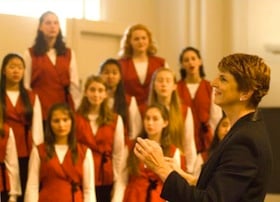 controversy is ongoing, even escalating.
controversy is ongoing, even escalating. Over the weekend several prominent members of the advisory board resigned in protest. Some of the information has been posted on the Web and on a “Save Susan” Facebook page, which includes a score of protests.
In a letter to board President Dorian Kingman Chong, who is also a former SFGC president and the spokesperson in the matter, James Meredith said the following:
By your own public admission, Susan has done everything asked of her, and more, meeting and exceeding expectations over her 10-year tenure. She was even highly praised by you at the recent gala. In that presentation it was acknowledged that she is highly respected by the local, national and international community for her artistic endeavors and her personal character. Shortly, after the gala, she was told that her contract would not be renewed. No discussion of why the board felt this was necessary was presented. Susan was only allowed to present her response to you at a follow-up meeting.Meredith, artistic director of the Sonos Handbell Ensemble, is a longtime collaborator with and former board member of the chorus. His note also mentions resignations by cellist Emil Miland and former San Francisco Symphony Chorus Director Vance George.A final 6 to 5 vote on this major issue by members present, with two resignations over the decision, is very telling. A board for this size organization needs to be larger and more representative than it currently is. ...
I would like to see the board postpone the contract decision, take some time to evaluate all of the community input, decide in great detail what you really want, counsel with professionals in the community as well as the artistic staff and then plan a substantial transition period if that is what you decide.
If you do not feel you can do this, then you should resign and let someone else take your places on the board. The whole process needs to be completely transparent to regain the respect and support of all of those who have a stake in the Girls Chorus. The fact that so many have raised concerns speaks to the esteem in which the organization is held. Do not trample lightly on that esteem.
George told Music News that his protest is against the “abrupt decision ... handled very badly by the board, staff and legal counsel.
“This economy has everyone in a twist. Suddenly people want to go in a different direction. A warning, some counsel and time should have been given to a person who has given so much to the chorus.
“A chorus is a living, breathing instrument. It is very human. Susan and the girls have been treated inhumanely. It is a matter of ethics and respecting the dignity of every human being that I object to. Boards and lawyers are notorious for this kind of treatment and in today’s world that is OK. They even make movies about it.”
The SFGC administration hasn’t responded to the new developments yet.
Top News #9: Levine Injured, Luisi Steps In, Withdraws From SFS Concerts
James Levine's precarious health suffered a new setback over the weekend, and the Metropolitan Opera music director announced on Tuesday that he is withdrawing from fall performances at the Met. Levine had emergency surgery in New York after a fall while on vacation in Vermont.Met General Manager Peter Gelb named Fabio Luisi as Levine's replacement, the Principal Guest Conductor now acting as Principal Conductor, while Levine retains the title of Music Director. Luisi will take over the podium for major fall projects, such as Siegfried, Don Giovanni, and others — in addition to operas already assigned to him.
An immediate consequence of these developments is Luisi's cancelation of performances with the Rome Opera, the Genoa Opera, the Vienna Symphony, and the San Francisco Symphony's Oct. 19-22 performances of the Verdi Requiem. SFS and the other organizations will now have to scramble to find replacements in a few days during the beginning of busy fall seasons — planned over many months — everywhere.
Top News #10: YouTube Orchestra's Must-Watch Finale
One of the most varied and fascinating classical music programs anywhere, the entire 2½-hour concert by 101 young artists from 33 countries, playing under the direction of Michael Tilson Thomas in the Sydney Opera House, is available online.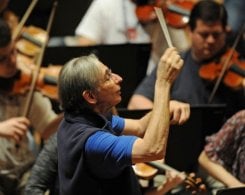
It is all well worth watching, both the performances and the colorful vignettes about participating artists, but here's help for selected viewing: This is the program, with the approximate time when each piece begins. Point at the little round icon on the bottom of the screen and you will see where you are in the program: You can drag it forward or backward.
Berlioz, Roman Carnival Overture (3:00); Percy Grainger, Arrival Platform Humlet (18:00); Bach, Toccata in F Major (22:00); Ginastera, "Danza del Trigo" and "Danza final" from Estancia — conducted by Ilych Rivas, who is just turning 18, younger than his fellow Venezuelan Gustavo Dudamel, (32:00); Mozart canon "Caro bell'idol mio" with Renée Fleming (42:00).
Britten-Purcell, Young Person's Guide to the Orchestra (48:00); didgeridoo piece (1:08:00); Mason Bates, Mothership (1:24:00); Mendelssohn Violin Concerto, last movement, with Stefan Jackiw, Rivas conducting (1:37:00); Abbas-Jacobsen, Ascending Bird, with Kseniya Simonova's sand paintings (1:48:00); Stravinsky, The Firebird excerpts (1:58:00); Schubert, Rosamunde excerpts (2:14:00).

